

Fourteen Interview Questions to Help You Hire Your Next Innovator. Partners using Energy Harvesting Wireless Sensor Solutions. EnOcean Alliance - Building Automation Experts. Funderbeam markets. What is VTC Group?

The VTC Group is a catalyst for growth; enabling SMEs to access the supply chains of multinational organisations. Our model revolutionises how pioneering small companies and established large corporates work together to drive innovation across the “Valley of Death” – the chasm every new business idea must conquer if they want to create a business and achieve growth. Our service and corporate advisory platform focuses on wealth creation; it reinvents the technology transfer process by working with Corporates, SMEs, Governments, Universities and Accelerators across four main business functions.
Bringing Outside Innovation Inside. In recent years, many companies have rediscovered a broad variety of models for external innovation, taking a page from the success of venture-backed startups that have disrupted multiple industries, including not just technology but also financial services, media and entertainment, travel and tourism, and marketing in general.

Corporate venture capital (CVC), accelerators and incubators, and innovation labs are again becoming more common, especially among large companies. BCG’s analysis of 210 top firms—the 30 largest companies in each of seven industries (automotive, chemicals, consumer goods, financial services, media and publishing, technology, and telecommunications)—found significant increases in the use of all three mechanisms between 2010 and 2015. (See Corporate Venturing Shifts Gears, BCG Focus, April 2016.) Casting a Wide Innovation Net. As the amount of data has burgeoned, so has the sophistication of the tools available to analyze and visualize it.

For example, BCG’s Center for Innovation Analytics uses a suite of tools and approaches to tap into multiple public and proprietary sources to help companies develop answers to tough questions about innovation and growth. These can pertain to identifying adjacent opportunities (including novel uses of a company’s existing capabilities), finding white-space opportunities, monetizing a company’s own intellectual property, identifying and screening potential acquisition targets and venture partners, and gaining an understanding of new technologies that represent a potential competitive threat.
Consider a hypothetical company that has an interest in moving into cybersecurity. Innovation analytics can be applied in a wide range of circumstances to gain insights that help set direction and strategy. Temaindkaldelser. Mutually Assured Disruption. Illustration by Kotryna Zukauskaite A version of this article appeared in the Spring 2016 issue of strategy+business.
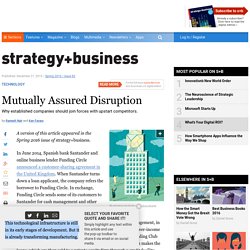
In June 2014, Spanish bank Santander and online business lender Funding Circle announced a customer-sharing agreement in the United Kingdom. When Santander turns down a loan applicant, the company refers the borrower to Funding Circle. Microsoft Starts Up. Illustration by Phil Hackett At the Microsoft Accelerator in Beijing, engineers are developing new technologies that could transform industries as diverse as automobiles, mobile telephony, and e-commerce.
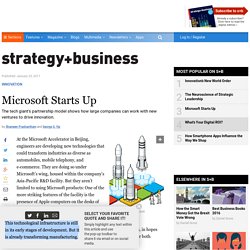
They are doing so under Microsoft’s wing, housed within the company’s Asia-Pacific R&D facility. But they aren’t limited to using Microsoft products: One of the more striking features of the facility is the presence of Apple computers on the desks of some of the roughly dozen startups working there. Sparking creativity in teams: An executive’s guide. Senior managers can apply practical insights from neuroscience to make themselves—and their teams—more creative.

Although creativity is often considered a trait of the privileged few, any individual or team can become more creative—better able to generate the breakthroughs that stimulate growth and performance. In fact, our experience with hundreds of corporate teams, ranging from experienced C-level executives to entry-level customer service reps, suggests that companies can use relatively simple techniques to boost the creative output of employees at any level.
The key is to focus on perception, which leading neuroscientists, such as Emory University’s Gregory Berns, find is intrinsically linked to creativity in the human brain. To perceive things differently, Berns maintains, we must bombard our brains with things it has never encountered. Immerse yourself. Seven steps to better brainstorming. Most attempts at brainstorming are doomed.
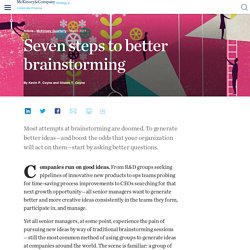
To generate better ideas—and boost the odds that your organization will act on them—start by asking better questions. Companies run on good ideas. From R&D groups seeking pipelines of innovative new products to ops teams probing for time-saving process improvements to CEOs searching for that next growth opportunity—all senior managers want to generate better and more creative ideas consistently in the teams they form, participate in, and manage. Yet all senior managers, at some point, experience the pain of pursuing new ideas by way of traditional brainstorming sessions—still the most common method of using groups to generate ideas at companies around the world. About us - Innovation Pioneers. Innovation Pioneers is a network founded by innovation leaders and practitioners from consumer, industrial, service and digital industries, experienced in strategic, tactical and operational management of innovation.
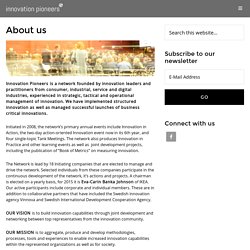
We have implemented structured innovation as well as managed successful launches of business critical innovations. Initiated in 2008, the network’s primary annual events include Innovation in Action, the two-day action-oriented Innovation event now in its 6th year, and four single-topic Tank Meetings. The network also produces Innovation in Practice and other learning events as well as joint development projects, including the publication of “Book of Metrics” on measuring innovation. The Network is lead by 18 Initiating companies that are elected to manage and drive the network. You Need an Innovation Strategy. Executive Summary Why is it so hard to build and maintain the capacity to innovate?

The reason is not simply a failure to execute but a failure to articulate an innovation strategy that aligns innovation efforts with the overall business strategy. Without such a strategy, companies will have a hard time weighing the trade-offs of various practices—such as crowdsourcing and customer co-creation—and so may end up with a grab bag of approaches. They will have trouble designing a coherent innovation system that fits their competitive needs over time and may be tempted to ape someone else’s system. And they will find it difficult to align different parts of the organization with shared priorities. Innovation Strategy: 4 Key Tactics of Top Growth Companies. Dave Power Dave Power is president of Power Strategy, where he helps growth companies with strategy, alignment, and execution.
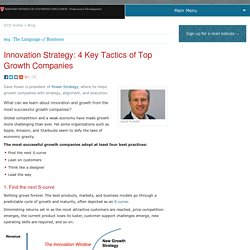
What can we learn about innovation and growth from the most successful growth companies?